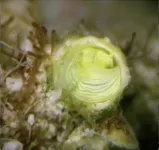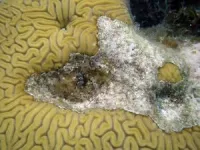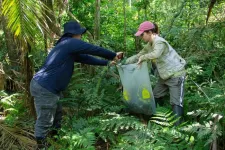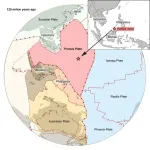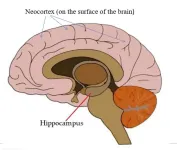(Press-News.org) The “Margaritaville” in Jimmy Buffett’s famous song isn’t a real place, but it’s long been associated with the Florida Keys. This string of tropical islands is home to the only living coral barrier reef in the continental US, along with many animals found nowhere else in the world. One of them is a newly-discovered, bright yellow snail, named in honor of Margaritaville. The lemon- (or, key-lime-) colored snail, along with its lime-green cousin from Belize, is the subject of a study published in the journal PeerJ.
These marine snails are distant relatives of the land-dwelling gastropods you might find leaving slimy trails in your garden. Nicknamed “worm snails,” they spend most of their lives in one place. “I find them particularly cool because they are related to regular free-living snails, but when the juveniles find a suitable spot to live, they hunker down, cement their shell to the substrate, and never move again,” says Rüdiger Bieler, curator of invertebrates at the Field Museum in Chicago and the study’s lead author. “Their shell continues to grow as an irregular tube around the snail’s body, and the animal hunts by laying out a mucus web to trap plankton and bits of detritus.”
Bieler has spent the past four decades studying invertebrate animals living in the Western Atlantic, but these particular snails “are so small and so well-hidden that we’ve not encountered them before during our scuba diving surveys. We had to look very closely,” he says. The new species belong to the same family of marine snails as the invasive “Spider-Man” snail that the same team described from the Vandenberg shipwreck off the Florida Keys in 2017.
He and his colleagues, including fellow Field Museum curator Petra Sierwald, came across the lemon-yellow snails in the Florida Keys National Marine Sanctuary, and they found a similar, lime-colored snail in Belize. “Many snails are polychromatic-- within the same species, you get different colors,” says Bieler. “In a single population, even a single little cluster, one might be orange, one might be gray. I think they do it to confuse fish and not give them a clear target, and some have warning coloration.”
“Initially, when I saw the lime-green one and the lemon-yellow one, I figured they were the same species,” says Bieler. “But when we sequenced their DNA, they were very different.”
Based on these molecular data, Bieler, Sierwald, and their co-authors Timothy Collins, Rosemary Golding, Camila Granados-Cifuentes, John Healy and Timothy Rawlings, placed the snails in a new genus, Cayo, after the Spanish word for a small, low island. The yellow snail was named Cayo margarita after the citrusy drinks in Jimmy Buffet’s “Margaritaville.” The lime snail’s name, Cayo galbinus, means “greenish-yellow.”
The Cayo snails have a key trait in common with another worm snail genus, Thylacodes, for which the team described a new species from Bermuda and named Thylacodes bermudensis. While only distantly related, these snails all have brightly colored heads poking out of their tubular shells. “Our thought is this is a warning color,” says Bieler. “They have some nasty metabolites in their mucus. That also might help explain why they're able to have exposed heads-- on the reef, everybody is out to eat you, and if you don't have any defensive mechanism, you will be overgrown by the corals and sea anemones and all the stuff around you. It seems like the mucus might help deter the neighbors from getting too close.”
Bieler says that the study is important because it helps illuminate the biodiversity of coral reefs, which are under severe threat due to climate change. “There have been increases in global water temperatures, and some species can handle them much better than others,” says Bieler. The Cayo snails have a tendency to live on pieces of dead coral, and as more coral is killed off, the snails might spread.
Moreover, says Bieler, “it's another indication that right under our noses, we have undescribed species. This is in snorkeling depth in a heavily touristed area, and we’re still finding new things all around us.”
This study was contributed to by scientists at the Field Museum, Florida International University, Queensland Museum, and Cape Breton University.
###
END
To address a crisis of unmet mental health needs among seniors with dementia and their family caregivers amid a shortage of mental health providers with expertise treating this population, McLean Hospital, a member of Mass General Brigham, has entered into an agreement to offer strategic advisory services and professional education to Rippl Care. Rippl provides specialty dementia care and is pioneering a new care model in an effort to expand access to high quality, wraparound behavioral healthcare for seniors, their families and caregivers. Under McLean’s agreement with Rippl Care, leaders in the ...
Advisory Highlights:
A new American Heart Association presidential advisory identifies the strong connections among cardiovascular disease (CVD), kidney disease, Type 2 diabetes and obesity, and suggests redefining CVD risk, prevention and management.
The advisory defines cardiovascular-kidney-metabolic (CKM) syndrome for the first time.
CKM syndrome ranges from Stage 0, or no risk factors and an entirely preventive focus, to Stage 4, the highest-risk stage with cardiovascular disease. Stage 4 may also include kidney failure.
The advisory urges use of a new tool that will predict someone’s likelihood of heart attack, stroke and/or heart failure ...
BOSTON – Although several medications are approved to treat attention-deficit/hyperactivity disorder (ADHD), some individuals experience limited benefits from the drugs or develop side effects from their use. A recent clinical trial published in the Journal of Clinical Psychiatry by investigators at Massachusetts General Hospital (MGH), a founding member of Mass General Brigham (MGB), has demonstrated that the drug solriamfetol may be an effective alternative for managing ADHD in adults.
Solriamfetol is currently approved in the United States for ...
A team of researchers from Queen Mary University of London and the University of Campinas in Brazil has found that tropical forest ecosystems are more reliant on aquatic insects than temperate forest ecosystems and are therefore more vulnerable to disruptions to the links between land and water.
The study, published in the journal Ecology Letters, is the first to directly compare the interconnections between land and water in tropical and temperate environments via the emergence of aquatic insects. The researchers used a technique called stable isotope analysis to trace ...
Utrecht University geologist Suzanna van de Lagemaat has reconstructed a massive and previously unknown tectonic plate that was once one-quarter the size of the Pacific Ocean. Her colleagues in Utrecht had predicted its existence over 10 years ago based on fragments of old tectonic plates found deep in the Earth’s mantle. Van de Lagemaat reconstructed lost plates through field research and detailed investigations of the mountain belts of Japan, Borneo, the Philippines, New Guinea, and New Zealand. To her surprise, she found that oceanic remnants on northern Borneo must have belonged to the long-suspected plate, which scientists have named Pontus. She has now reconstructed ...
An international team of scientists have discovered a huge spike in radiocarbon levels 14,300 years ago by analysing ancient tree-rings found in the French Alps.
The radiocarbon spike was caused by a massive solar storm, the biggest ever identified.
A similar solar storm today would be catastrophic for modern technological society – potentially wiping out telecommunications and satellite systems, causing massive electricity grid blackouts, and costing us billions of pounds.
The academics are warning of the importance ...
A new study found that an alternative model to identify patients with lung cancer eligible for screening was more accurate than the currently used method based on the United States Preventive Services Task Force (USPSTF) criteria. The results are published by Wiley online in CANCER, a peer-reviewed journal of the American Cancer Society.
Lung cancer is the leading cause of cancer deaths, and using low-dose computed tomography scans to screen people who are at elevated risk for lung cancer reduces lung cancer deaths. The USPSTF criteria use age and smoking history to determine ...
Type of work: peer-reviewed/randomised controlled trial/people
SSRI antidepressants normally take a few weeks before any showing mental health benefits, but how come it takes so long? Now a study from a group of clinicians and scientists provides the first human evidence that this is due to physical changes in the brain leading to greater brain plasticity developing over the first few weeks of SSRI intake. This may also begin to explain one of the mechanisms of how antidepressants work.
This work is presented at the ECNP conference in Barcelona on 9th October. This ...
Type of work: Peer-reviewed / experimental study / people
Up to a third of mothers don’t bond well with their babies after birth, causing intense emotional distress to both mother and baby1. Now researchers have found that they can train at-risk expectant mothers to recognise and regulate emotions better, potentially reducing their risk of postpartum depression.
Presenting the work at the ECNP Congress in Barcelona, researcher Dr Anne Bjertrup said:
People generally have an automatic tendency to see the positive or negative in any situation. In previous studies we saw that certain ...
A loving bond between parents and their children early in life significantly increases the child’s tendency to be ‘prosocial’, and act with kindness and empathy towards others, research indicates.
The University of Cambridge study used data from more than 10,000 people born between 2000 and 2002 to understand the long-term interplay between our early relationships with our parents, prosociality and mental health. It is one of the first studies to look at how these characteristics interact over a long period spanning childhood and adolescence.
The researchers ...

